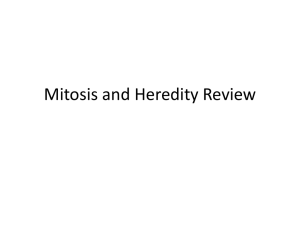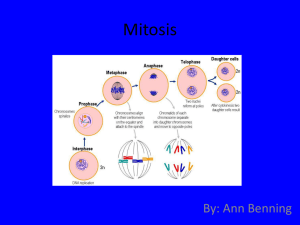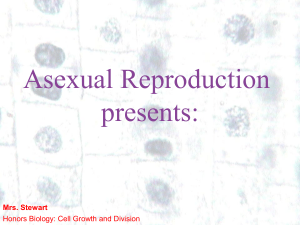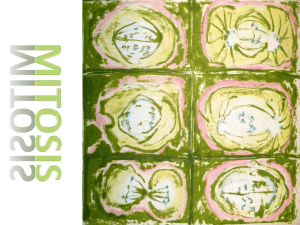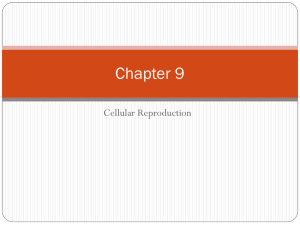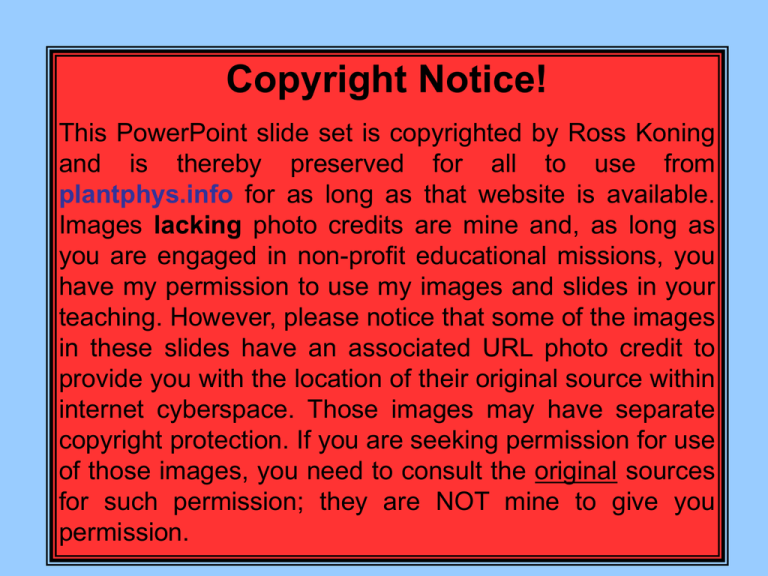
Copyright Notice!
This PowerPoint slide set is copyrighted by Ross Koning
and is thereby preserved for all to use from
plantphys.info for as long as that website is available.
Images lacking photo credits are mine and, as long as
you are engaged in non-profit educational missions, you
have my permission to use my images and slides in your
teaching. However, please notice that some of the images
in these slides have an associated URL photo credit to
provide you with the location of their original source within
internet cyberspace. Those images may have separate
copyright protection. If you are seeking permission for use
of those images, you need to consult the original sources
for such permission; they are NOT mine to give you
permission.
Seed Germination Analysis Worksheet
Total germinated
after 4-days of
initial treatment
Total germinated in 7 days
(including after 3-days of
followup white exposure)
___ ___ of 50
___ ___ of 50
red light
___ ___ of 50
___ ___ of 50
far-red light
___ ___ of 50
___ ___ of 50
darkness
___ ___ of 50
___ ___ of 50
Initialtreatment
white light
Use only t he dat aaft er t he init ial treat mentto compare t he dark cont rolwit h:
Decision on
T reat ment ffect
e on
null hypot hesis
seed germinat ion
T reat ment Z-t est p-value
reject cannotreject
stimu lates ineffective inhib its
white light __ . __ __ __
red light
far-red light
.
__ . __ __ __
__ __ __ __
reject cannotreject
stimu lates ineffective inhib its
reject cannotreject
stimu lates ineffective inhib its
Use all t he dat ato comparet he init ial result s (control) with t he result s aft er whit e-followup:
Init ial
Decision on
Followup effect on
T reat ment Z-t est p-value
null hypot hesis
seed germinat ion
reject cannotreject
stimu lates ineffective inhib its
white light __ . __ __ __
red light
far-red light
darkness
.
__ . __ __ __
__ . __ __ __
__ __ __ __
reject cannotreject
stimu lates ineffective inhib its
reject cannotreject
stimu lates ineffective inhib its
reject cannotreject
stimu lates ineffective inhib its
Use only t hedat a aft er seven days (after 3-days of white light followup exposure) t o compare t he
init ial dark cont rolgroup with t hoseinit ially t reated wit h:
Init ial
Decision on
Init ialtreat menteffect on
t reat ment
null
hypot
hesis
final seed germinat ion
Z-t est p-value
reject cannotreject
stimu lates ineffective inhib its
white light __ . __ __ __
red light
far-red light
.
__ . __ __ __
__ __ __ __
reject cannotreject
stimu lates ineffective inhib its
reject cannotreject
stimu lates ineffective inhib its
Biology:
life study of
What is Life?
Properties of Life
Cellular Structure: the unit of life, one or many
Metabolism: photosynthesis, respiration,
fermentation, digestion, gas exchange,
secretion, excretion, circulation--processing
materials and energy
Growth: cell enlargement, cell number
Movement: intracellular, movement, locomotion
Reproduction: avoid extinction at death
Behavior: short term response to stimuli
Evolution: long term adaptation
Growing
Cell Division
Prokaryotic Growth
• Cells are generally very small
• Cells may double in size but only before
binary fission
• Growth mostly in terms of cell number or
colony size, etc.
• Doubling time in cell numbers may be 20
minutes in ideal conditions
• Could quickly take over the earth if conditions
could remain ideal
• Very competitive in ideal environments
• Ultimate survivors - 3.5 billion years!
Binary Fission: Bacteria and Archaea
cytokinesis by furrowing
replication
migration
Process called binary fission
NOT mitosis!
•Genome and copy are identical
•Genome is haploid
•There is no synapsis
•There is no recombination
Compare Fig. 11.8
Pg. 230
In archaeons, there are multiple DNA circles in the genome to
start, and how their replication and movements are coordinated
so that all progeny contain one of each circle is not known.
We know what is going on in this slide, right?
QuickTime™ and a
TIFF (Uncompressed) decompressor
are needed to see this picture.
http://library.thinkquest.org/3564/Cells/cell91.gif
Eukaryotic Growth
• Cells are generally much larger than prokaryotes
• Cells may double in size before mitosis
• Growth can be by increasing cell numbers and/or by
increasing cell size…body complexity is another
dimension of eukaryotic growth
• Mitosis only refers to nuclear division and must be
coordinated with or preceded by binary fission of
chloroplasts and mitochondria (the endosymbionts) to
ensure that all progeny cells have complete cell
components
• Eukaryotic genomes are distributed over several linear
DNA molecules, are associated with histone proteins, and
these must be replicated and moved in a coordinated way
to avoid cells with incomplete genomes
• There are several styles of cytokinesis among eukaryotic
organisms (including furrowing)
Eukaryotic Cell Cycle
cytokinesis
mitosis
PMAT
postsynthesis gap
1
M
G2
7
presynthesis gap
G1
10
interphase
S
6
Compare Fig. 11.5
Pg. 227
DNA synthesis
Eukaryotic Cell Cycle
Interphase nucleus looks
normal with intact nuclear
envelope, chromatin,
nucleolus, active
transcription
postsynthesis
gap
cytokinesis
mitosis
PMAT
1
M
G2
7
10
interphase
S
nucleus larger,
chromatin darker,
two nucleoli
G1
6
DNA synthesis
presynthesis
gap
nucleus
smaller,
chromatin
lighter, one
nucleolus
binary fission of
mitochondria,
chloroplasts and
centriole in
interphase!
early
late
chromosome
centromere
------Prophase---------
Mitosis = PMAT
2 sister
chromatids
Prophase:
1. Transcription stops
G2
Interphase
G1
2. Duplicated chromosomes condense
3. Nucleolus disappears
4. Nuclear envelope disappears
5. Chromosomes in cytosol
SEM of prophase
chromosome
The coiled loops
making up the
chromosome
consist of DNA
wrapped around
histone proteins,
and then coiled
together tightly to
form the two
sister chromatids
http://cellbio.utmb.edu/cellbio/Nucchr2.jpg
Artificially dyed SEM of the human prophase chromosomes
The human karyotype shows 46 (23 pairs) of chromosomes
http://www.thednastore.com/images/mousepads/mouse2.jpg
http://employees.csbsju.edu/hjakubowski/classes/SrSemMedEthics/Human%20Genome%20Project/chromosomes2.gi
An organized
karyotype of
a dividing cell
from a female
human
A SEM image
of the male
human’s Y
chromosome
Compare Fig. 12.6
Pg. 252
The male sex
chromosome
combination:
one X
chromosome
and one Y
chromosome
http://www.exitmundi.nl/xy.gif
GENES ON THE Y CHROMOSOME
Adapted from http://teachers.oregon.k12.wi.us/cowan/Images/Y%20chromosome%20genes.JPG
Testis Determining Factor (TDF)
P
11.32
11.31
Gadgetry (MAC-locus)
11.2
Channel flipping (FLP)
Catching and throwing (BLZ-1)
11.1
The x-chromosome has
1000 genes critical to both
males and females.
The y-chromosome has 86
genes for only 23 different
proteins.
11.1
11.21
Self-confidence (BLZ-2) [unlinked to ability]
11.22
Q
Ability to remember and tell jokes (GOT-1)
Sports page affinity (BUD-E)
11.23
SRY is the gene modifying
early development to
convert the female body into
a male.
Addiction to death and destruction movies (T-2)
Air guitar behavior (RIF)
Aircraft identification memory (DC10)
Youth fascination with Arachnida, Reptilia (MOM-4U)
Spitting behavior (P2E)
12
The other 85 are malespecific genes dealing with
spermatogenesis or sperm
function.
Reading on the john (SIT)
Inability to express affection over the phone (ME-2)
Selective hearing loss (HUH?)
Lack of recall after dates (OOPS)
OBVIOUS SPOOF!
Inherited from father to son,
the sequences found on this
chromosome can show
genealogy of humans
Note: the location of
haplogroups on earth
are still indicative of what
are believed to be
ancient migration routes
of Homo sapiens.
http://www.jewsandjoes.com/images/FTDNA-Migration-Map.jpg
early
late
------Prophase--------Metaphase
Mitosis = PMAT
Metaphase:
1. Spindle microtubules form at poles
G2
Interphase
G1
2. Spindle fibers from each pole attach to
centromeres
3. Spindle fibers push chromosomes to
equatorial plane
early
late
------Prophase--------Metaphase
Mitosis = PMAT
G2
Interphase
G1
Anaphase:
1. Spindle microtubules
shorten probably by
depolymerization at ends
2. Centromeres break
down, freeing sister
chromatids
3. Sister chromatids are
pulled to opposite poles
Anaphase
early
late
------Prophase--------Metaphase
Mitosis = PMAT
late
G2
1. Nuclear envelope reappears
2. Chromosomes decondense
3. Transcription resumes
early
Interphase
G1
cell plate cytokinesis
Anaphase
Telophase
early
late
------Prophase--------Metaphase
Mitosis = PMAT
late
G2
early
Interphase
G1
cell plate cytokinesis
Anaphase
Telophase
©1996 Norton Presentation Maker, W. W. Norton & Company
Mitosis in the
African Blood
Lily
(Scadoxus
multiflorus)
Compare Fig. 11.0
Pg. 231
http://publications.nigms.nih.gov/insidethecell/images/ch4_mitosisstages.jpg
Can you identify the
phases of the cell cycle?
©1996 Norton Presentation Maker, W. W. Norton & Company
Animal mitosis: Frog heart endothelium
Can you identify the phases of the cell cycle shown here?
Compare Fig. 11.0
Pg. 231
©1996 Norton Presentation Maker, W. W. Norton & Company
Evolution of the role of the nuclear envelope among eukaryotes
Dinoflagellates
Common
early
late
Eukaryotes
Centriole association with the spindles only ensures cells receive one
in species where centrioles are needed (flagellated)…are we?
http://faculty.rmc.edu/wmartin/public_html/images/catenaria.jpg
©1996 Norton Presentation Maker, W. W. Norton & Company
Nuclear membrane role during mitosis in fungi (Catenaria)
Catenaria zoospores proliferating in
zygote (“egg”) of a midge
and inside the body of a nematode
http://www.cals.ncsu.edu/course/pp318/nem/CHO49.JPG
Different modes of cytokinesis among eukaryotes
Animal cell
Fungal cell
Algal cell
Plant cell
furrowing
budding
phycoplast
phragmoplast
©1996 Norton Presentation Maker, W. W. Norton & Company
Cytokinesis: Furrowing cleavage in a frog zygote
Saccharomyces: yeast from kingdom Fungi
Mitosis nearly complete
Cytokinesis via extrusion: budding!
?
?
?
http://www.jhu.edu/iic/Yeast_1.png
?
©1996 Norton Presentation Maker, W. W. Norton & Company
Cytokinesis
A phragmoplast
developing between two
cells of root meristem in
corn (Zea mays)
This potassium
permanganate
preparation for TEM
shows membranes
almost exclusively, so
cytoplasm looks “simple”
as do mitochondria.
Note: nice Golgi
(dictyosomes)!
Cm destroyed
Eukaryotic Cell Cycle
Control
signal
c
m
cdkM
cm
cytokinesis
mitosis
PO4 PMAT
PO4
cdkM
cdkI
1
PO4
10
interphase
messenger
cs active
G1
7
active cm
cdkM
cdkM
[Cs] rises
cs
cdkI
M
G2
phosphorylation
inactive
cdk
cdkS
cdkS
cs
messenger
cdkS
S
PO4
6
cm
[Cm] rises
cdkI
phosphorylation
DNA synthesis
inactive
cdkI
cdk
PO4
signal
cs
cdkS
PO4
Cs destroyed





